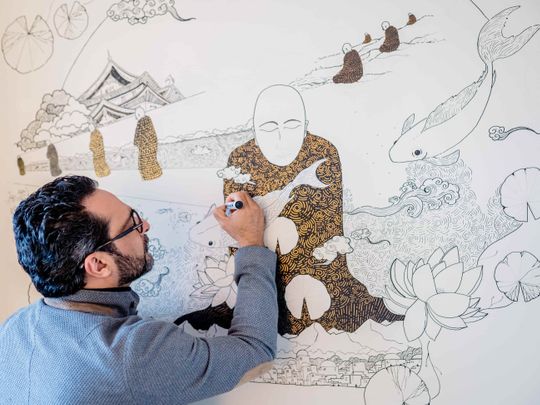
When his compatriots saw Dubai-based businessman Sajith Ansar doodling as he sat through a two-hour meeting, they stared aghast. It was as if he didn’t care about the future of their company, the branding and creative design agency Idea Spice, or where their partnerships were headed. Not believing that he was ‘paying attention no matter what he said’, they asked him questions based off recent discussions. He answered them without the bat of an eye, adding additional bits of information or opinion in select spots. Now, they stared at him with their mouths agape as Ansar waited for the discussion to continue. He was also almost done with his newest drawing, part of a series called ‘Monk and Koi’, which he’s readying to publish in book format.
He calls this drawing habit of his a meditative experience, one that allows him to be fully present to the deal, conversation, or moment at hand. “People used to wonder what I’m up to. Now it’s me - across different business groups they know, that’s how I listen or that’s how I am,” says Ansar in an interview with Gulf News.
It’s not an uncommon finding, say psychologists about focusing and doodling – there’s a definite link. In a study in 2009, for instance, psychologist Jackie Andrade asked 40 people to listen to a 2-minute-thirty-second boring, rambling voice message, half of whom were asked to doodle while monitoring it. They were then asked questions about the message. Findings suggest those that doodled had 29 per cent better information recall than those who did not.
For Ansar, who practices drawing monks and koi fish every day for “15-20 minutes in the morning” that period has become one of contemplation.
“I’ve been doing the same thing for about 5-6 years. It’s been my form of meditation. If I were to trace it back, when I went to Kyoto on a trip to Japan. I hadn’t planned anything - I had just started drawing. When I was drawing monks I decided to do it with a lot of details. [And it became] a form of meditation,” says the 47-year-old UAE resident from Kerala, who recalls the serenity he felt in the Japanese city when he went to the Kyoto Gardens.
“I’ve done hundreds and hundreds of them - in larger formats, for myself. I’ve had people constantly asking to buy, I’ve just found it difficult to do it. So I’ve just been making and keeping it. I’ve done larger full walls in the office, and at home with details,” he adds. Now, Ansar is planning a book, expected mid-year, detailing his journey and showcasing these works of intricacy.
The process of creation is one of quiet indifference. “I finish a piece in about 2 hours. I spend about 10-15 minute a day - depending on the size of it. The longer ones - like the ones I do in a meeting are larger ones - that’s 2.5 hours of focused time. But there are smaller ones. And surprisingly these happen quite fast …I’ve done one in the house which is 2 m high and 1.5 m wide on glass and that took a few hours over two days,” he says.
And there’s a huge difference in the evolution of his thoughts which can be seen in his work, he claims. “If you look at my first drawing and my latest there’s a huge range in terms of discovery, quality, quietness. Initially, it was about trying to depict monks and then it became just…there’s no plan it’s just free flowing and that shows in the calmness and it shows in the drawing itself,” he says.
Maybe this is because the type of art Ansar practices qualifies as meditative drawing. “Meditative drawing allows for non-judgmental expression of feelings, in ways words cannot.
The inner critic is silent and a creative flow takes over. The end result is a clearer and calmer self,” explains Sneha John, Clinical Psychologist, Camali Child & Adult Mental Health.
Perhaps it is this mindfulness and commitment to cathartic process that allows for Ansar’s success; he’s been listed in Forbes Middle East for three years in the top 100 Indian leaders list.
Or perhaps it’s just the conversations between the monk and the fish.








